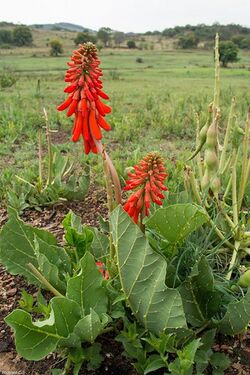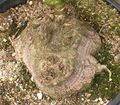Biology:Erythrina zeyheri
| Ploughbreaker | |
|---|---|

| |
| Scientific classification | |
| Kingdom: | Plantae |
| Clade: | Tracheophytes |
| Clade: | Angiosperms |
| Clade: | Eudicots |
| Clade: | Rosids |
| Order: | Fabales |
| Family: | Fabaceae |
| Subfamily: | Faboideae |
| Genus: | Erythrina |
| Species: | E. zeyheri
|
| Binomial name | |
| Erythrina zeyheri | |
Erythrina zeyheri, commonly known as the ploughbreaker, is a deciduous, geoxylic subshrub and member of the Fabaceae, which is endemic to southern Africa. It grows no more than 60 cm tall[1] and occurs naturally in the higher elevation grasslands of South Africa's central plateau, and that of adjacent Lesotho.[2] They favour deep clay soil in the vicinity of creeks and marshes, and often form colonies.[1] Its specific name commemorates the 19th century botanist, Karl Zeyher.
Description
It is a geoxylic plant, sometimes called an "underground tree",[3] that produces annual stems, some 50 to 60 cm long.[4] It has glabrous, leathery, trifoliolate leaves with large leaflets. The rachis and main leaf venation, which are prominently raised below, are armed with recurved spines on both leaf surfaces.[5] The petioles and stems are likewise armed to discourage browsers. The shoots and leaves are deciduous, dying away during harsh highveld winters,[1] when the plant survives as an extensive woody, tuberous rootstock.
The upright inflorescences appear in summer, with the leaves,[4] from October to January.[1] The drooping scarlet, or rarely white flowers,[5] are capped by a red calyxes. Their fruit are smooth black pods when mature, each containing a few large (1.0 to 1.7 cm long) seeds.[4] These are hard and orange-red in colour.[1][5]
Foodplant
It is a foodplant for the moth Terastia margaritis.[6]
Gallery
-
Abaxial leaf surface armed with recurved spines on main veins
-
The perennial tuberous rootstock
-
Green pods and seed
References
- ↑ 1.0 1.1 1.2 1.3 1.4 "Erythrina zeyheri". PlantZAfrica.com. South African National Biodiversity Institute. http://www.plantzafrica.com/plantefg/erythrinzey.htm. Retrieved 19 December 2012.
- ↑ Reports of its occurrence in Botswana and Zimbabwe are suspect, see: "Erythrina latissima E. Mey. (Notes)". Flora Zambesiaca. kew.org. http://apps.kew.org/efloras/namedetail.do?flora=fz&taxon=2156&nameid=5251. Retrieved 21 December 2012.
- ↑ Barras, Colin. "Why some trees evolved to live underground". http://www.bbc.com/earth/story/20141103-why-some-trees-live-underground. Retrieved 27 April 2017.
- ↑ 4.0 4.1 4.2 Schmidt, Ernst; Lötter, Mervyn; McCleland, Warren (2002). Trees and shrubs of Mpumalanga and Kruger National Park. Johannesburg: Jacana Media. p. 488. ISBN 9781919777306.
- ↑ 5.0 5.1 5.2 van Wyk, Braam (1988). Veldgids tot die Veldblomme van die Witwatersrand en Pretoria. Cape Town: Struik. pp. 206–207. ISBN 0-86977-815-3.
- ↑ Goff, R.. "Terastia margaritis". African Moths. http://www.africanmoths.com/pages/CRAMBIDAE/SPILOMELINAE/terastia%20margaritis.html. Retrieved 21 December 2012.
External links
- Colony of Erythrina zeyheri after a grass-fire, Operation wildflower
Wikidata ☰ Q1651786 entry
 |




